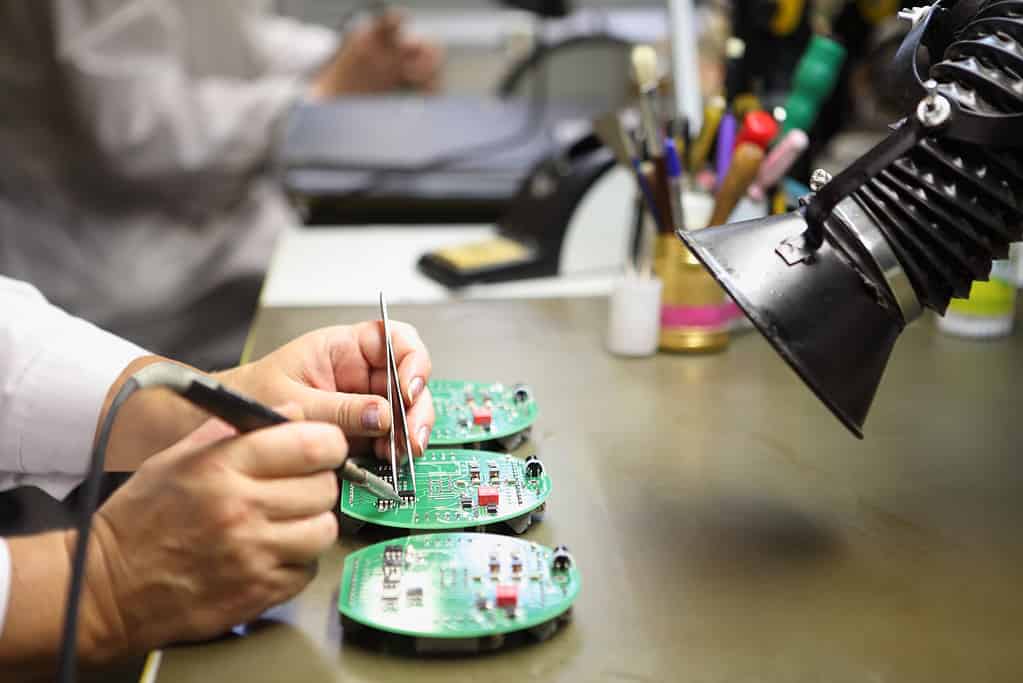
© Golden Dayz/Shutterstock.com
Key Points
- Artificial intelligence is shaking up industries.
- AI allows workers to undertake more complex and difficult tasks while ignoring repetitive tasks.
- Understanding how to mitigate teething problems leads to increased productivity with AI.
- There is a lack of transparency with some major AI firms, OpenAI in particular faces scrutiny.
- Artificial intelligence can make decisions people might not even consider.
If you haven’t paid attention to the news over the last two years, you’ve likely missed the buzz surrounding AI. Artificial intelligence has touched down in a big way over the last couple of years. Products and services like ChatGPT, Midjourney, and Google Gemini have entered the cultural zeitgeist. Now, that’s fine and dandy for your average consumer, but how is it impacting industries?
Let’s take a deeper dive into how these products are transforming and disrupting industries.
AI Entering the Workplace

At first glance, artificial intelligence has quite a bit going in its favor. For starters, a monthly subscription for ChatGPT or outsourcing customer service support to chatbots is far cheaper than paying employees to handle the same tasks.
Further, we’re seeing AI enter business in a big way, whether it’s small or larger implementations as a whole. For the tech-wary in the audience, it can seem somewhat daunting to even consider replacing jobs with artificial intelligence. However, there are some benefits to consider:
- Less Overhead
- Can Handle Data Analysis
- Frees Up Employees for Complex or Creative Tasks
- Leads to an Increase in Productivity in Organizations
However, these benefits also have their drawbacks. Artificial intelligence is by no means perfect, as we’ll explore further.
Artificial Intelligence In Use
Rather than an exhaustive dive into the subject, I find it best to hone in on a few specific areas of interest. AI is certainly here to stay, but let’s explore the impact it is having in some key sectors. Chief among those I’m considering are finance, healthcare, and manufacturing. Now, artificial intelligence is working well when considering the likes of e-commerce. However, it poses challenges in different industries.
AI in Finance
If you’re simply looking to take some of the busy work out of statistical analysis, then artificial intelligence is providing nothing but smooth sailing in finance. With some choice prompt selection, you have workers freed up to handle tasks that certainly require a human touch. However, when you start looking at other aspects of its implementation, it poses some unique problems.
Artificial intelligence is fallible, let’s just go ahead and get that out of the way. It is trained on data sets that are years out of date. If you’re using this resource as a means of research, you run the risk of hallucinations conjured up by the Large Language Models at the heart of their operation.
That isn’t to say it is unusable, but those in finance certainly need to pick and choose their use cases. Notably, Nike has been using it for analyzing customer data. For the last few years, artificial intelligence has been at the heart of its statistical analysis, crunching numbers in sales, customer satisfaction, and other hard data points.
IBM is championing the use of artificial intelligence in finance, citing custom algorithms for trading, automation of time-consuming tasks, and handling compliance and regulation for certain industries. That said, as a former cybersecurity specialist, I would hire an auditor once a quarter to make sure your ducks are in a row.
Artificial Intelligence in Manufacturing

Skilled specialists running CNC machines, lathes, and other industrial machinery are still needed, so we’ll just get that out of the way. However, like finance, artificial intelligence is gaining ground in analysis. When you consider the size and scope of any commercial manufacturing facility, having hard data readily collated, organized, and analyzed is a major boon.
That said, specialty-designed AI robots are entering the automotive industry. Ford uses something called cobots, which handle quality control, welding, and other menial tasks. BMW likewise uses AI-driven robots for similar tasks, freeing up workers and saving a fair bit annually in the process.
Likewise, we’re seeing the use of AI in other aspects of manufacturing. NVIDIA, one of the driving forces behind artificial intelligence, is utilizing its own hand-rolled models for placing transistors onto silicon. This work is tedious when done by hand, and can result in lost time and materials in the event of a slip or mistake.
Artificial Intelligence in Healthcare
Healthcare is always going to be a contentious subject, especially for those stateside. There are numerous regulations to keep in mind when implementing any new technology into healthcare. While your average business running afoul of something like the PCI-DSS or other compliances can expect hefty fines and jail time, healthcare has far harsher penalties.
That said, AI is gaining solid ground in healthcare. One of the key ways the technology is being implemented in healthcare is through the use of distributing information online. As seen during the COVID-19 pandemic, the need for accurate and up-to-date information is paramount. Circumstances changed frequently before life resumed as normal.
People can only move so fast during the day, but a user looking for accurate information could readily find it through a custom bot for a hospital or doctor’s office. Further, artificial intelligence is being used in a similar way as seen in finance. The human body isn’t a spreadsheet, but data can predict issues that arise.
While the technology isn’t quite up to speed on handling diagnoses and treatments, it is picking up the slack readily. Currently, the most impressive thing is the Mayo Clinic using artificial intelligence to diagnose and predict heart problems in patients. These sorts of symptoms might be missed by a trained doctor, but a trained model picks it up with ease.
The Drawbacks of AI
It isn’t all a bed of roses when talking about the implementation of artificial intelligence. I’ve used a fair bit of your time just discussing the benefits seen. However, as with any new technology, there are some definite problems to consider when thinking about implementing AI in the workplace.
Let’s cover a few of the prime sticking points, at least when considering the impact it has on your organization.
Cost

Any new technology is going to be quite expensive to implement. Think about replacing workstations for your office employees, you’re talking an order of magnitude when considering new machines. Now, with artificial intelligence, you’re either hiring engineers to develop it in-house, or you’re outsourcing a platform.
Developing it in-house takes time and money. Further, it will fall victim to the same pitfalls seen through any software development project. However, unlike the principles of software development demonstrated in the likes of Lean or Agile, this is something you’re using in-house.
Further, it is going to take time to integrate it into your current technology stack. For the more tech-savvy readers out there, I know you understand the pain and frustration that comes from switching to something like a new operating system. Those are products with thousands of people working behind the scenes.
Just imagine the teething pains you’ll encounter when integrating an all-new platform into your technology stack. Cost doesn’t just come down to the monetary cost, after all.
Limitations
You’ve no doubt experienced a chatbot in your downtime from work. I stumble across them just about daily, depending on the sites I’m visiting. Often, these can be helpful, but real issues aren’t readily solved without a human touch. This is just one of the limitations of artificial intelligence, but there are more to consider.
Artificial intelligence is in its infancy, at least when compared to more mature technologies. As such, there is a lack of expertise around it. Now, if you’re hiring personnel to handle the likes of troubleshooting Linux, managing compliance, or other technical tasks, there is no shortage of talented hires on the market.
However, AI has been in the mainstream for a couple of years. In those couple of years, we’ve seen great leaps, but mostly when looking at the consumer-facing market. Further, these technologies are far from stable. From my time in information technology, we leaned on stable and proven platforms until the need to update finally came up.
It is a nightmare to consider updating a platform you’re relying on regularly. A proper strategy needs to be in place, as with any new technology implemented in the workplace. Having a roadmap and mitigation strategies to ensure business continuity is key.
The limitations are hard to ignore, especially given the marketing and hype around AI. While it seems like a panacea for everything ailing your organization, it is just another tool.
Ethical Concerns

We’ve covered a few of the more galling drawbacks of artificial intelligence. However, there is one we haven’t discussed in full: the human cost. There are some massive ethical concerns raised with the implementation of AI in the workplace.
Chief among those is the replacement of workers. Your average worker is an investment for any given organization. You’re placing time, resources, and training into a person to function as a reliable part of your organization. So, what happens if AI makes that job redundant?
Letting go of employees causes a drop in morale, but might be necessary. Further, moving workers into different roles is going to require another considerable investment to re-train and place them in a suitable position.
Another major ethical concern beyond the human cost does still have people at its core. AI isn’t without bias, after all, these platforms are created by people. Everyone has biases, it is impossible to be completely impartial. This bias is filtered through the AI, especially when you consider the data sets used for training.
Transparency
Given my background in technology, I’m used to seeking out documentation and other findings to shed some light on a given platform before its implementation. However, artificial intelligence has a notable lack of transparency behind the major platforms.
Firms like OpenAI aren’t championing open-source software. When you get down to it, there is a shocking lack of information on how these technologies are trained, deployed, and serviced. Now, this might not be of concern to your rank-and-file worker, but it does pose unique challenges for those in charge.
That isn’t to say all firms are lacking transparency, but the Foundational Model Transparency Index has written extensively on the subject.
Tools That Boost Productivity
You don’t need the newest and freshest technologies to see an increase in productivity. After all, if you’re here, you’re likely already interested in Six Sigma. If you’re looking for a way to make the most of your data analysis, understanding the principles behind an F-value and ANOVA works wonders. You can find out more in our comprehensive guide.
Likewise, if you’re looking to get to the root of a problem, something as basic as the 7 QC tools utilized in Six Sigma can go a long way. Getting to grips with these tools is far simpler than implementing a whole new technology stack in your organization. You can find out all about them in our guide, which is a fairly brisk read.
Conclusion
So, is AI going to solve all that ails your business? Probably not, but some definite benefits are being seen in a variety of industries. However, like any platform there are drawbacks. Learning to balance those aspects and put a solid strategy in place yields the best results. As with any new technology, make sure you do your due diligence before integrating it into your organization.
The image featured at the top of this post is ©Golden Dayz/Shutterstock.com.